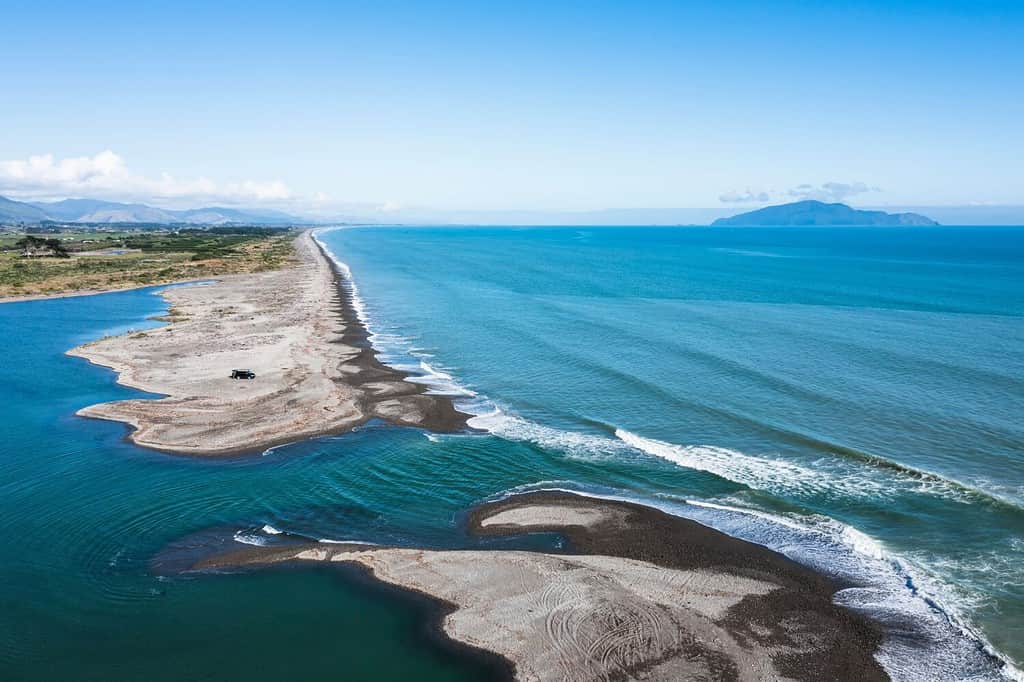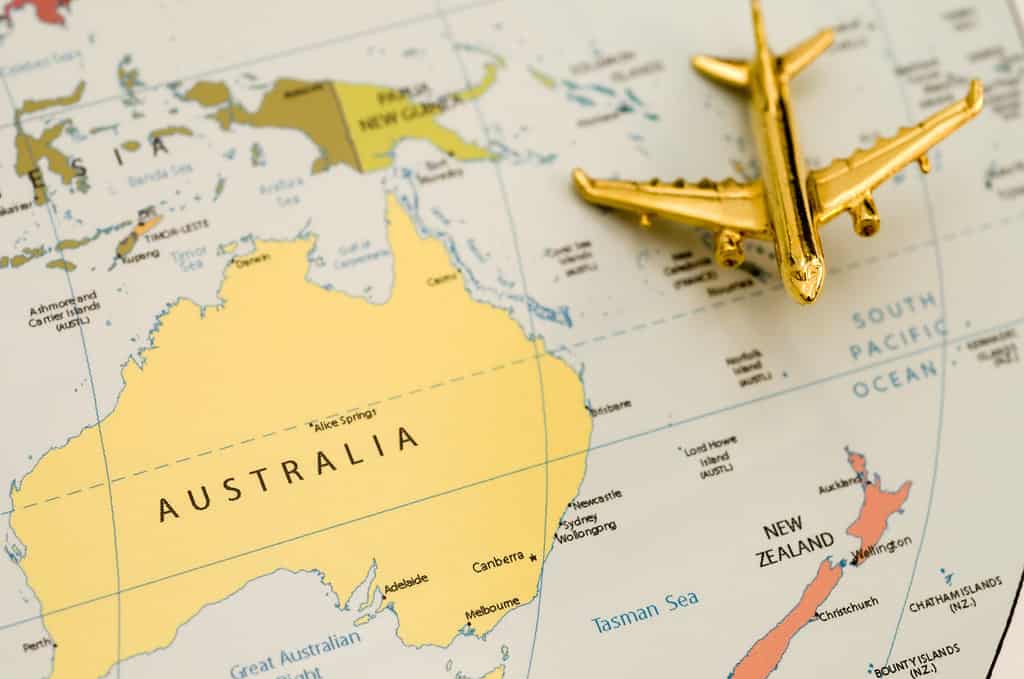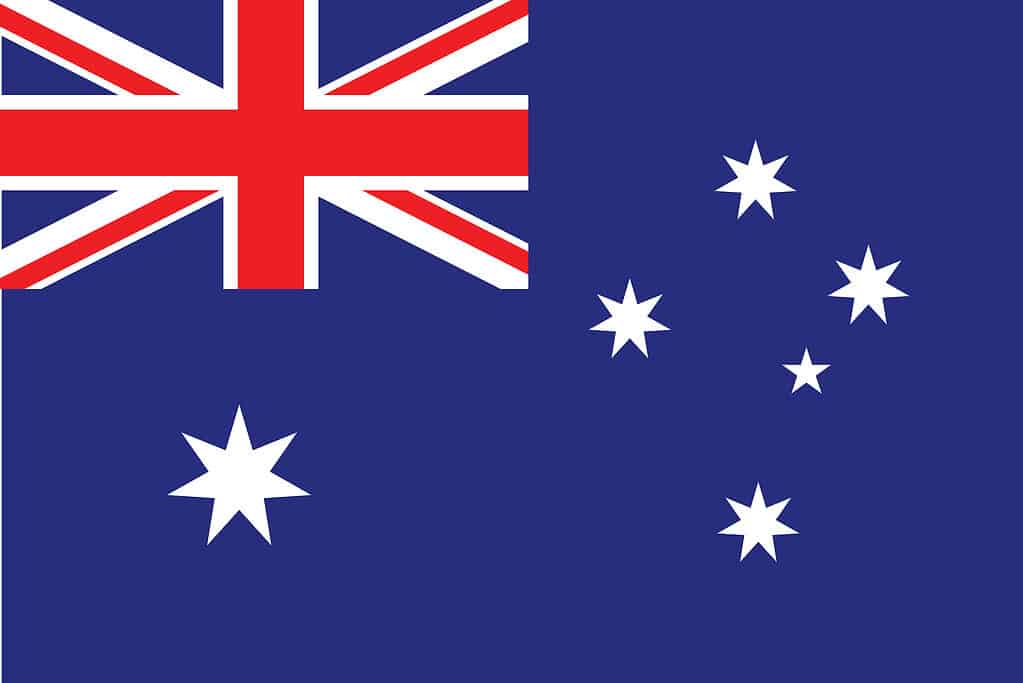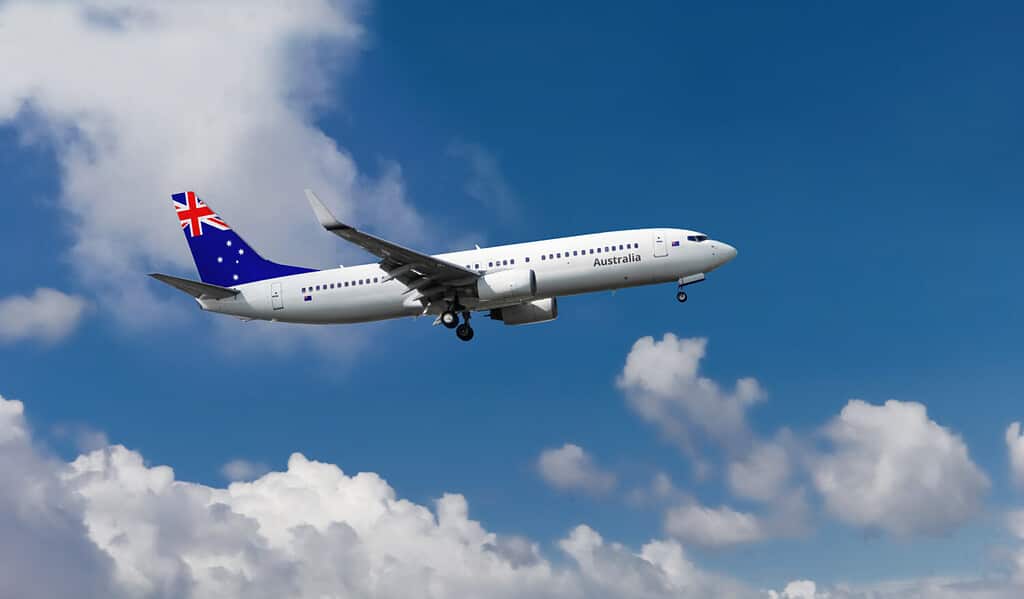Australia and New Zealand have a lot of similarities. They are neighbors in the South Pacific. Both have large indigenous populations, and both had British colonies with large numbers of Europeans. To outsiders, it can be difficult to tell Aussies and Kiwis apart. They have many cultural similarities and tend to have easygoing, friendly personalities. They both speak English in pleasant accents that sound quite similar to an untrained ear. As if that weren’t enough, the flags of both countries are nearly identical as well. In this article, we’ll look at the key differences (and similarities) between the Australian vs. New Zealand flags. We’ll help you tell them apart and understand their unique symbolism. And at the end, we’ll show you a proposed design for a new New Zealand flag (a “Newer” Zealand flag?) See whether you like it better than the original.

The beautiful Tasman Sea, a part of the South Pacific Ocean, divides Australia and New Zealand.
©Wirestock Creators/Shutterstock.com
Why are Australia and New Zealand Separate Countries?
Geographical and Cultural Distance
If Australia and New Zealand are so similar, why aren’t they one country? When they became independent, Australia left the constitutional door open for New Zealand to become an Australian state. An obvious obstacle is the 2,500 miles that separates them. This was a much greater hinderance in the early 1900s than it is today, but a barrier to unity, nonetheless. Moreover, just because two countries share similarities, doesn’t mean they should be one country. The same type of question comes up about other similar countries, like the United States and Canada. This can be quite disrespectful of the value of each country and what it has achieved on its own.

The Tasman Sea separates Australia and New Zealand, which are independent of one another.
©Jesse Kunerth/Shutterstock.com
The Question of Indigenous Rights
One of the main reasons New Zealand did not want to join Australia, was the latter’s treatment of native peoples. After independence, New Zealand’s indigenous Maori population enjoyed voting rights in the colony, whereas Australians disenfranchised the Aboriginals. New Zealand feared that Australians would disrespect Maori rights, and this could create unrest. This is not as much an issue today, as Australia has broadened its democracy. However, New Zealand has not shown interest in changing the status quo.
In recent years, some have suggested a wider Pacific Union. This would include both countries, as well as 14 other South Pacific island nations. It would focus more on free trade and developing a common currency than political issues, at least initially. If the past is any indication, though, New Zealanders are quite content as they are. The country doesn’t see overwhelming advantages to joining Australia.

The indigenous Maori people are a vital and influential part of New Zealand’s culture.
©Molly NZ/Shutterstock.com
The Australian Flag: Description and Symbolism
A British maritime flag inspired the Australian flag, which includes the British Union Jack in the upper left corner to honor the country’s heritage as a part of the British Empire. The remainder of the flag is a blue field reminiscent of the ocean or the night sky. To the right side of the flag is a depiction of the Southern Cross – a prominent constellation in the Southern Hemisphere essential to navigation for early explorers. Another symbolic meaning of the Southern Cross comes from Dante, who used the four main stars to represent the qualities of justice, prudence, temperance, and fortitude. Below the Union Jack is a large additional white star. This is the Commonwealth Star. It originally had six points to represent the six British colonies on the continent of Australia that federated to form the independent country. Later, officials added a seventh point to represent the territory of Papua New Guinea, which for a time was under Australian administration.

Australia’s flag has a white star beneath the Union Jack, which distinguishes it from New Zealand flag.
©iStock.com/Ardani Saputro
New Zealand Flag: Description and Symbolism
New Zealand’s flag, like Australia’s, was based on a British maritime flag and it includes the Union Jack for the same reason: to honor and celebrate their historical connection to Great Britain. However, in depicting the Southern Cross, it shows only the four main stars, without a small additional one, and it also does not include the large Commonwealth Star. The New Zealand flag’s stars are five-point red stars with white outlines. These differences are what you need to look for to tell the two flags apart. Additionally, the Southern Cross on New Zealand’s flag is a meaningful symbol to the Maori people. Their mythology refers to it as Māhutonga, a hole in the Milky Way through which storm winds escaped.

Unlike Australia’s flag, the flag of New Zealand has red five-pointed stars outlined in white.
©iStock.com/LysenkoAlexander
Proper Flag Etiquette
Australian Flag Etiquette
These are some of the rules provided by the Australian government for the proper display of the national flag:
- In Australia, it must be flown in a superior position to other flags.
- It should not be flown at night unless it is illuminated.
- It should not be flown upside down.
- Worn flags should not be displayed. They are to be disposed of in a respectful way. It is acceptable to cut an old flag into small pieces and place it in a waste bin.
- It can be flown at half-mast to mourn the passing of a nationally significant individual.
- In advertising, it should not be overprinted with words or pictures.
In Australia, currently, there is no law against burning or desecrating the flag, although there have been numerous attempts to pass one. Many people, including some political leaders, see it as a matter of free speech and a legitimate means of public protest.

Advertisers can use the Australian flag, as long as they use it in a dignified way.
©Mateusz Atroszko/Shutterstock.com
New Zealand Flag Etiquette
In New Zealand, it is against the law to alter the flag or to dishonor it in public by displaying it improperly or destroying it. Breaking this law is punishable by a fine of up to $5,000. The flag should never be flown in a dilapidated condition. There is no official Flag Day in New Zealand and no pledge of allegiance. The flag may be flown at half-mast to signify mourning for the death of well-known individuals at the discretion of the Ministry for Arts, Culture, and Heritage. This department provides detailed instructions for properly displaying the New Zealand flag in different official and informal situations.

These sports fans are not out in public, and they intend to express national pride, not dishonor the flag.
©Viktoriia Hnatiuk/Shutterstock.com
A “Newer” Zealand Flag?
Some citizens of Australia and New Zealand are critical of both flags because they include the Union Jack. This may give the appearance that these countries are still under Great Britain leadership. There has been a particularly strong movement in New Zealand to replace the flag with something that will be more distinguishable from Australia’s and incorporate more local cultural elements.
After a national debate over many different options for new flags, the leading contender became a flag that combines the current flag with the “silver fern” flag which is a popular symbol of the people of New Zealand as well. The combined flag keeps the blue field and red stars of the current flag, removes the Union Jack, and uses a silver fern on a diagonal border between the blue and black fields of the background. Black, white, and red are traditional colors of the Maori people. The many individual parts of the fern front represent the various peoples of New Zealand’s diverse population, all working together and growing upward as one nation. Of several possible designs, this one was the favorite. And in 2016, people decided whether to adopt it or keep the current flag. More than 50% of the population voted to retain the original flag.

New Zealand’s new flag design did not get enough support to replace the current flag.
©Ramunas Bruzas/Shutterstock.com
What Do You Think?
What’s your opinion on some of the controversies about the Australian and New Zealand flags?
- Are flag desecration laws necessary or are they an intrusion on free speech?
- Should the countries remove the Union Jack from both flags to make a stronger statement of national independence?
- Should New Zealand change its flag to be less like Australia’s and include more Maori elements?
If you could design a new flag for New Zealand yourself, what colors and designs would you choose? Give it a try and email it to New Zealand. Maybe in a few more years we’ll be revising this article to include your design as the new flag of New Zealand!
The photo featured at the top of this post is ©
Thank you for reading! Have some feedback for us? Contact the AZ Animals editorial team.






